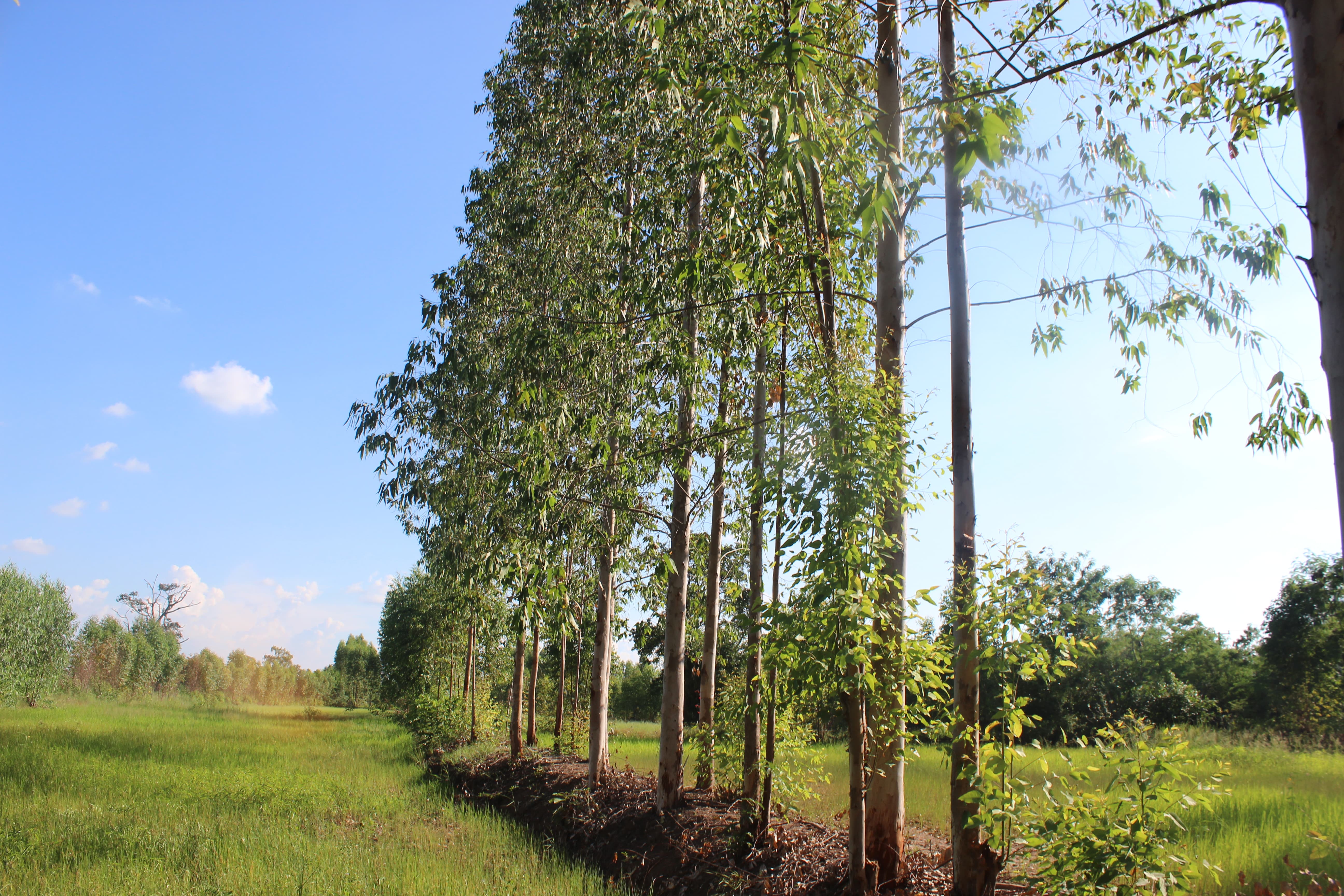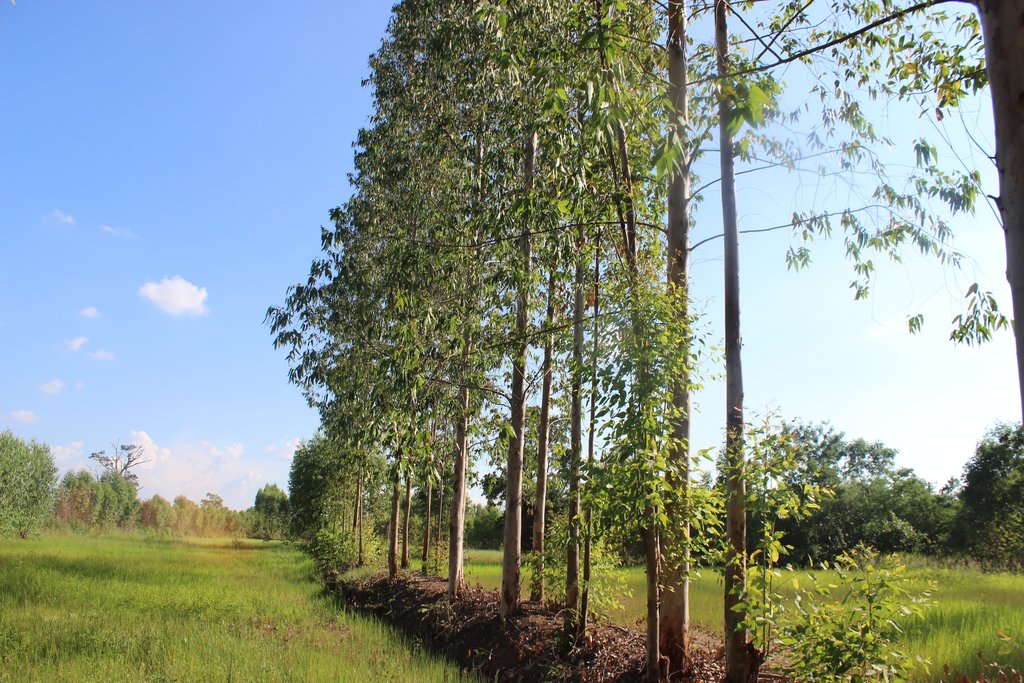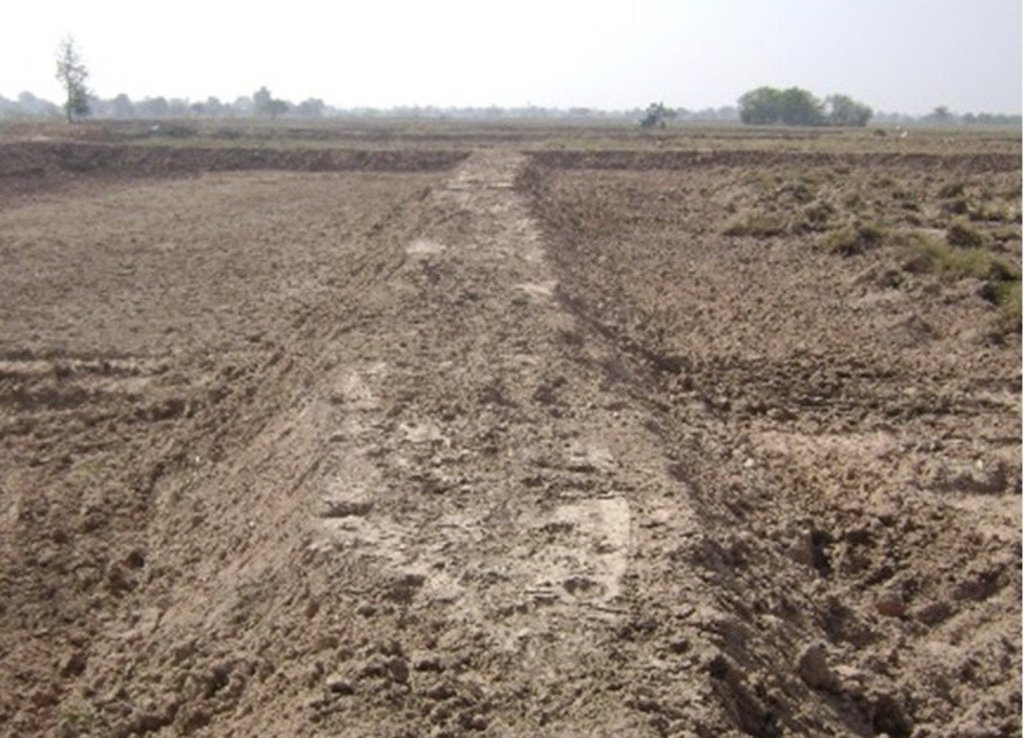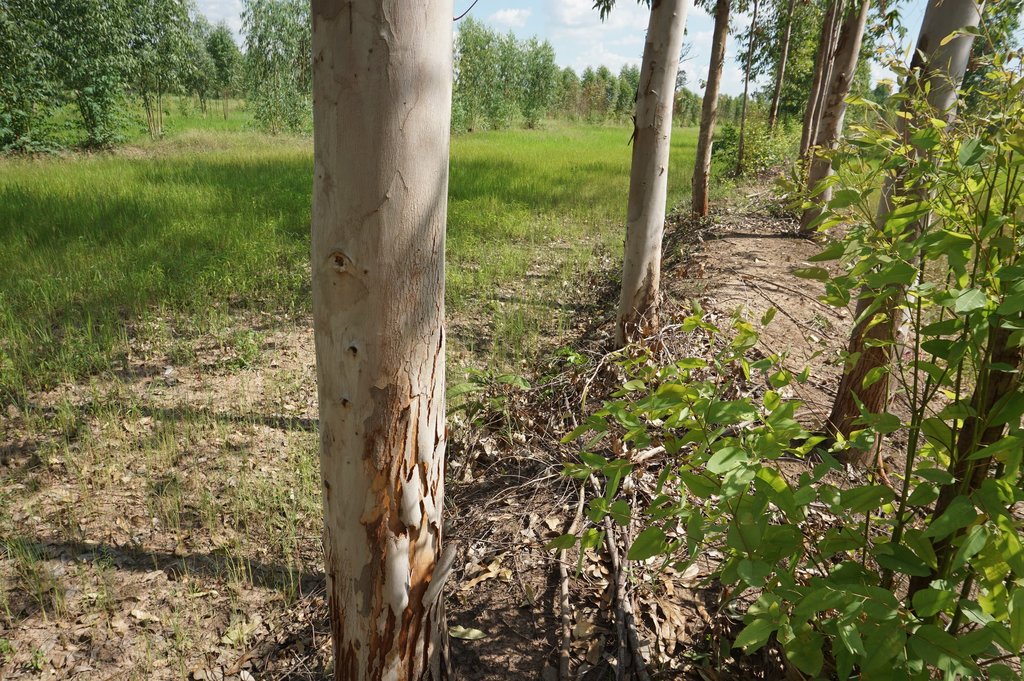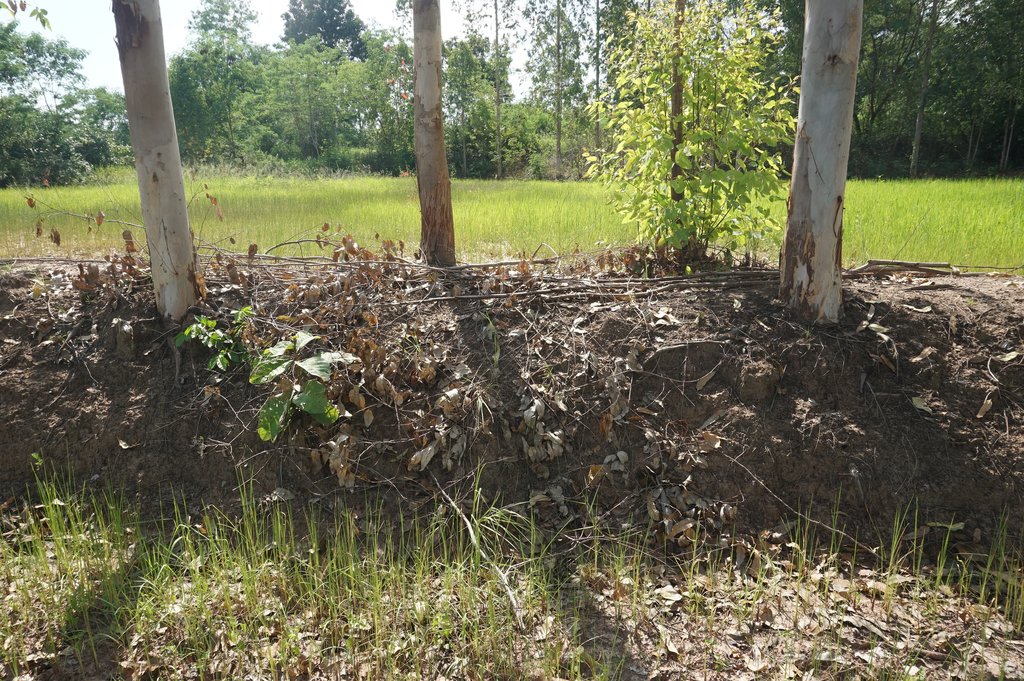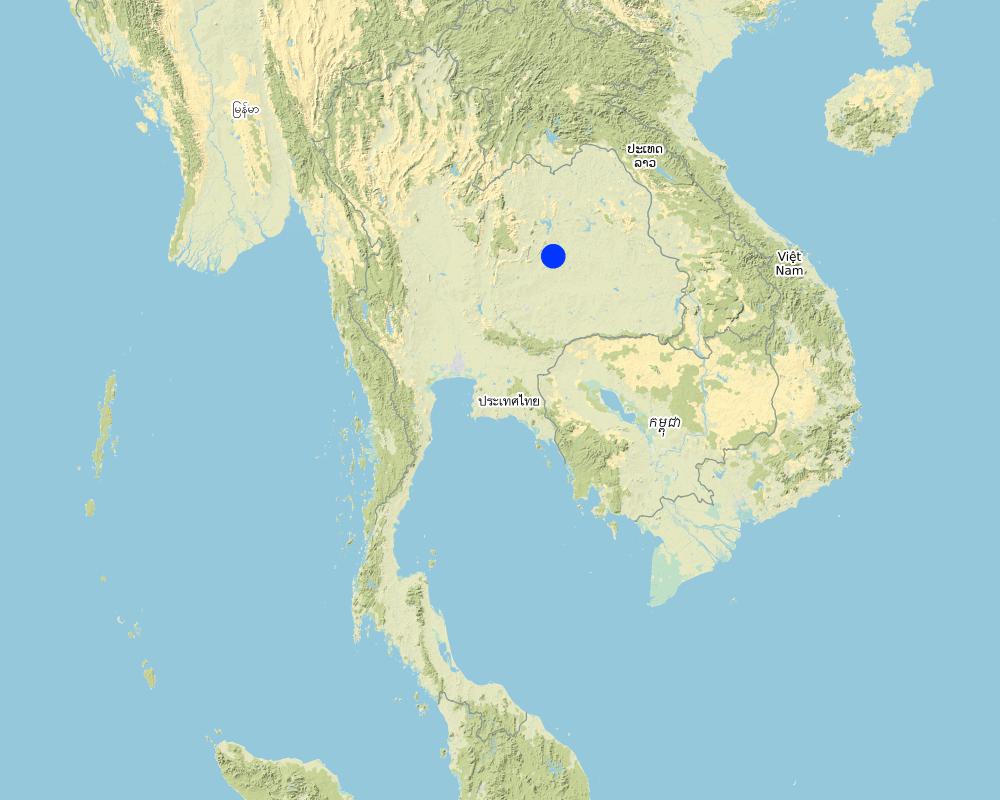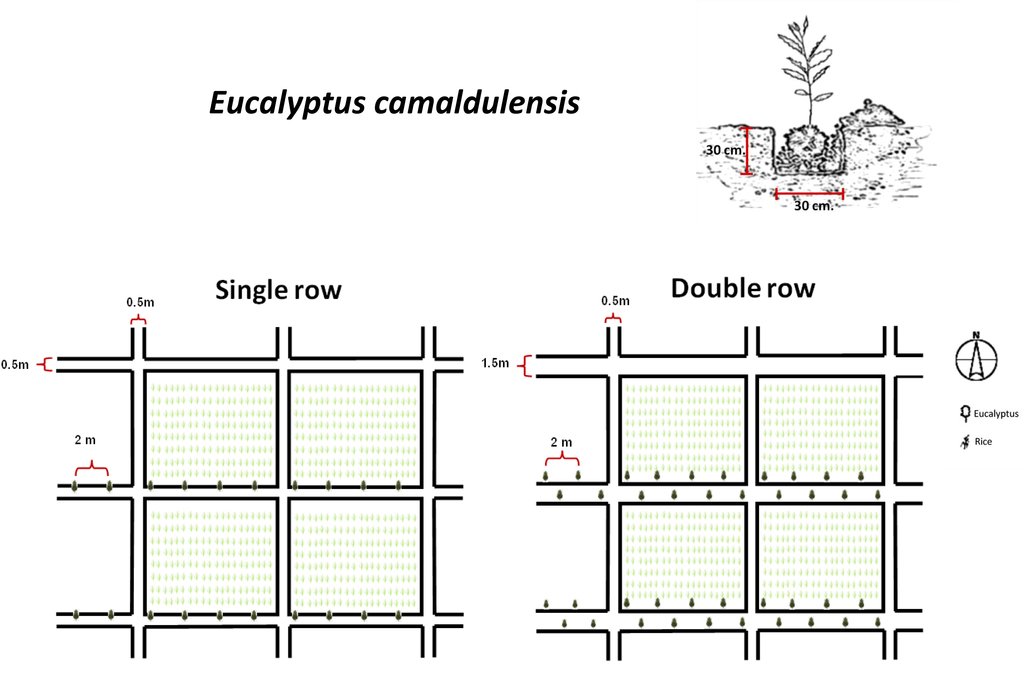Planting Eucalyptus on rice bunds to lower saline groundwater [Thailand]
- Creation:
- Update:
- Compiler: Areerat Wangkaew
- Editor: –
- Reviewers: Rima Mekdaschi Studer, Samran Sombatpanit, Pitayakon Limtong, William Critchley
Planting perennial salt-tolerant trees in salt-affected areas of the Northeast of Thailand.
technologies_4099 - Thailand
View sections
Expand all Collapse all1. General information
1.2 Contact details of resource persons and institutions involved in the assessment and documentation of the Technology
Key resource person(s)
land user:
Chuenchai Sayan
+66-99-0254108
Ban Muang Pia, Muang Pia Sub-district, Ban Phai District, Khon Kaen 40110
Thailand
SLM specialist:
Sritumboon Supranee
ssritumboon@yahoo.com
Land Development Department
2003, 61 Phaholyothin Road, Ladyao, Chatuchak, Bangkok 10900
Thailand
SLM specialist:
Pothinam Pornpana
laosuwan18@hotmail.com
Land Development Department
2003, 61 Phaholyothin Road, Ladyao, Chatuchak, Bangkok 10900
Thailand
SLM specialist:
Rophandung Weera
weerop@hotmail.com
Land Development Department
2003, 61 Phaholyothin Road, Ladyao, Chatuchak, Bangkok 10900
Thailand
SLM specialist:
Srihaban Pranee
pranee.782@gmail.com
Land Development Department
2003, 61 Phaholyothin Road, Ladyao, Chatuchak, Bangkok 10900
Thailand
SLM specialist:
Jakkarach Usa
usa.kl@hotmail.com
Land Development Department
2003, 61 Phaholyothin Road, Ladyao, Chatuchak, Bangkok 10900
Thailand
SLM specialist:
Janplang Chettaruj
joeshua9@hotmail.com
Land Development Department
2003, 61 Phaholyothin Road, Ladyao, Chatuchak, Bangkok 10900
Thailand
National consultant:
Arunin Somsri
ssarunin@gmail.com
Land Development Department
2003, 61 Phaholyothin Road, Ladyao, Chatuchak, Bangkok 10900
Thailand
Name of project which facilitated the documentation/ evaluation of the Technology (if relevant)
Decision Support for Mainstreaming and Scaling out Sustainable Land Management (GEF-FAO / DS-SLM)Name of the institution(s) which facilitated the documentation/ evaluation of the Technology (if relevant)
Land Development Department LDD (Land Development Department LDD) - Thailand1.3 Conditions regarding the use of data documented through WOCAT
When were the data compiled (in the field)?
01/10/2018
The compiler and key resource person(s) accept the conditions regarding the use of data documented through WOCAT:
Yes
1.4 Declaration on sustainability of the described Technology
Is the Technology described here problematic with regard to land degradation, so that it cannot be declared a sustainable land management technology?
No
Comments:
The technology is environmentally suited and very well accepted by the land users.
1.5 Reference to Questionnaire(s) on SLM Approaches
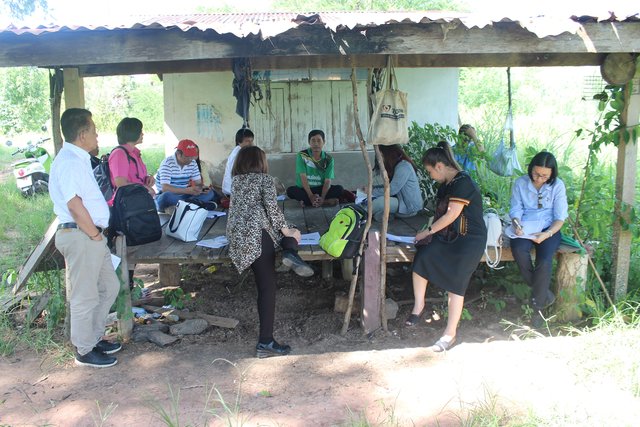
Advisory system for planting Eucalyptus camaldulensis on rice … [Thailand]
The Thai government promotes planting of Eucalyptus camaldulensis on rice bunds to lower the saline groundwater level and prevent the spread of salt in soils - through cooperation of farmers, land owners, Siam Forestry Co., Ltd., Subdistrict Administration Organization, Land Development Department, and with specialists/ technical advisors.
- Compiler: Areerat Wangkaew
2. Description of the SLM Technology
2.1 Short description of the Technology
Definition of the Technology:
Eucalyptus camaldulensis variety H4 is salt tolerant and has the ability to lower shallow saline groundwater levels; as a result salinity is controlled. Planting eucalyptus on one or two sides of the rice bund in an east-west direction (in single or double rows) at a spacing of 2 m between trees is the most effective technique and well accepted by farmers.
2.2 Detailed description of the Technology
Description:
Eucalyptus camaldulensis cultivation on rice bunds to lower shallow saline groundwater levels in low-lying areas is a technology used on salt-affected land. The LDD Perennial Tree Planting project to promote the technology of planting Eucalyptus camaldulensis on rice bunds has been implemented since 1996. The land user interviewed cultivates a moderately salt-affected rice field at Ban Muang Pia District, Khon Kaen Province. The land is used for rice production both glutinous (variety RD 6) and non-glutinous fragrant rice (Hom Mali 105). The average yield of rice is 200-250 kg/rai (1 ha = 6.25 rai). The farmers have planted eucalyptus on bunds in the rice cultivated areas on about 10,000 rai in more than 10 years with the objectives of remedying and preventing salination by lowering shallow saline groundwater levels, through "bio-drainage" as well as increasing income and better utilization of lands on rice bunds for growing trees.
The technology of eucalyptus cultivation on rice bunds has been implemented in farmers' fields in the low-lying salt-affected rice area common in the Northeast of Thailand. It is widely accepted by farmers through the joint partnership between the Land Development Department (LDD), Siam Forestry Co., Ltd. and the local district administration. Eucalyptus seedlings are provided by LDD and are planted in a single or double rows - double rows with trees planted on two sides of the rice bunds in a zigzag manner following an east-west direction to prohibit a shadow effect. The spacing between the trees in a row is 2 m: the rice bund was adapted to be 1.5 m wide and 0.5 m high. This provides more space and convenient access to the rice field. The project provides labour costs for farmers to prepare the land before planting. Many farmers outside the project transplanted their own eucalyptus seedlings on the bunds of 0.5 m or more in width. Farmers buy the seedlings at 1 THB each and plant in pits of 0.3 x 0.3 x 0.3 m with 0.5 kg compost and 0.5 kg rice husks from farm by-products. This technology is well accepted by farmers because of the effective control of salinity in the rice fields as well as the higher income obtained from selling eucalyptus wood. Farmers observed the dead patchy spots of rice plants with salt crusts before planting eucalyptus: after 2 cutting cycles no salt patches were observed anymore, and rice yields increased noticeably. There was also extra income from selling poles of eucalyptus every 4 years. The average yield of eucalyptus trees of 2.5-3.0 inches in diameter was 16 tons per rai for the first cutting.
Based on 7 years (2 crops of eucalyptus coppicing), the average additional income was 1,087 THB/rai/yr (according to the farmers' and Siam Forest's information). The main investment was in the first year of planting; later on, the maintenance cost was on labour for weeding, pruning and thinning to 3 stems after coppice/cutting, including adding 15-15-15 fertilizer for each tree. The average income is increased through better rice yields. The benefits of the technology according to interviews are creating a cooler microclimate from eucalyptus trees and changes in biodiversity through better soil quality resulting in more species of flora and fauna such as grasses, wildflowers, dragonflies, earthworms in the rice field and on the bund. Some farmers wanted more trees by planting at closer spacing of 1 m, but this resulted in too great a density of trees thus consuming more surface water and competing with rice for water consumptive use.
2.3 Photos of the Technology
2.4 Videos of the Technology
Comments, short description:
The video shows the area of eucalyptus growing on the rice bund.
Date:
01/10/2018
Location:
Ban Muang Pia, Khon Kaen
Name of videographer:
Supranee Sritumboon
Comments, short description:
Farmer interview and SLM discussion.
Date:
01/10/2018
Location:
Ban Muang Pia, Khon Kaen
Name of videographer:
Supranee Sritumboon
2.5 Country/ region/ locations where the Technology has been applied and which are covered by this assessment
Country:
Thailand
Region/ State/ Province:
Khon Kaen
Further specification of location:
Ban Phai
Comments:
The SLM Technology site for planting eucalyptus in a rice production area.
Map
×2.6 Date of implementation
Indicate year of implementation:
1996
2.7 Introduction of the Technology
Specify how the Technology was introduced:
- through projects/ external interventions
- by other land users
Comments (type of project, etc.):
The project initiated by the government (Land Development Department) collaborated with private enterprises (Siam Forestry Co., Ltd.), local administration, communities and land users.
3. Classification of the SLM Technology
3.1 Main purpose(s) of the Technology
- improve production
- reduce, prevent, restore land degradation
- preserve/ improve biodiversity
- create beneficial economic impact
3.2 Current land use type(s) where the Technology is applied

Cropland
- Annual cropping
- Perennial (non-woody) cropping
Main crops (cash and food crops):
Rice
Comments:
Planting eucalyptus for additional income and more intensive utilization of land on the rice bunds.
If land use has changed due to the implementation of the Technology, indicate land use before implementation of the Technology:
Before planting eucalyptus, rice was the only crop. Due to the shallow saline groundwater of the area, rice had shown symptoms of being salt-affected; however after planting eucalyptus trees, these symptoms disappeared.
3.3 Further information about land use
Water supply for the land on which the Technology is applied:
- rainfed
Comments:
Average annual rainfall is 1,200-1,300 mm.
Number of growing seasons per year:
- 1
Specify:
Land use is for rice production; the technology is planting Eucalyptus camaldulensis on rice bunds.
Livestock density (if relevant):
Only few cattle, swine, and boar are in the land user's farm.
3.4 SLM group to which the Technology belongs
- agroforestry
- ground water management
- desalination
3.5 Spread of the Technology
Specify the spread of the Technology:
- evenly spread over an area
If the Technology is evenly spread over an area, indicate approximate area covered:
- 1-10 km2
Comments:
The technology has spread over the area of 10,000 rai (1 ha = 6.25 rai) owned by farmers/land users both under and outside the supported project of planting eucalyptus on rice bunds.
3.6 SLM measures comprising the Technology

agronomic measures
- A2: Organic matter/ soil fertility
- A5: Seed management, improved varieties

other measures
Comments:
Eucalyptus camaldulensis H4 is the salt-tolerant variety used for lowering shallow saline groundwater.
3.7 Main types of land degradation addressed by the Technology

chemical soil deterioration
- Cn: fertility decline and reduced organic matter content (not caused by erosion)
- Cs: salinization/ alkalinization

physical soil deterioration
- Pc: compaction
- Pk: slaking and crusting

biological degradation
- Bc: reduction of vegetation cover
- Bq: quantity/ biomass decline
- Bs: quality and species composition/ diversity decline
- Bl: loss of soil life

water degradation
- Hg: change in groundwater/aquifer level
- Hq: decline of groundwater quality
3.8 Prevention, reduction, or restoration of land degradation
Specify the goal of the Technology with regard to land degradation:
- reduce land degradation
- restore/ rehabilitate severely degraded land
Comments:
Decreased saline groundwater levels to control salinity distribution in rice cultivated areas.
4. Technical specifications, implementation activities, inputs, and costs
4.1 Technical drawing of the Technology
4.2 Technical specifications/ explanations of technical drawing
1. Seedling of Eucalyptus camaldulensis H4, a salt-tolerant variety, were planted. The age of seedlings was 3-month old. The rice bund was regulated to 0.5 m wide for planting eucalyptus in single row or 1.5 m wide for planting in double rows (in a zigzag manner), 0.5 m high with a spacing of 2 m between the trees along an east-west direction. The number of trees was 80/rai or 500/ha for double rows planting.
2. Planting technique: 0.5 kg of compost mixed with 0.5 kg of rice husks was applied at the bottom of a pit of 0.3 x 0.3 x 0.3 m before seedlings were planted.
4.3 General information regarding the calculation of inputs and costs
Specify how costs and inputs were calculated:
- per Technology area
Indicate size and area unit:
own by one selected land user
If using a local area unit, indicate conversion factor to one hectare:
1 hectare = 6.25 rai
other/ national currency (specify):
THB
Indicate exchange rate from USD to local currency (if relevant): 1 USD =:
32.0
Indicate average wage cost of hired labour per day:
300 THB
4.4 Establishment activities
| Activity | Type of measure | Timing | |
|---|---|---|---|
| 1. | Site selection of salt-affected area | Structural | May-July |
| 2. | Land preparation; bunds construction and seedling preparation | Structural | May-July |
| 3. | Public hearing, joint meeting between farmers and researchers | Other measures | May-July |
| 4. | Demonstration plot | Agronomic | May-July |
| 5. | Model establishment (Eucalyptus planting method) | Agronomic | May-July |
| 6. | Joint monitoring, evaluation and follow up for planting | Other measures | After planting |
Comments:
No irrigation water therefore the planting time depends on the period of early rainy season which will be from May to July.
4.5 Costs and inputs needed for establishment
| Specify input | Unit | Quantity | Costs per Unit | Total costs per input | % of costs borne by land users | |
|---|---|---|---|---|---|---|
| Labour | Labour cost for planting eucalyptus (labour wage per day = 300 THB, 1 rai required a labour cost of 600 THB) | Rai | 1.0 | 600.0 | 600.0 | |
| Plant material | Eucalyptus seedling cost (80 trees/rai), 1 THB for each seedling | Seedling | 80.0 | 1.0 | 80.0 | |
| Fertilizers and biocides | Compost cost 3.5 THB/kg, 0.5 kg/pit | kg | 40.0 | 3.5 | 140.0 | |
| Fertilizers and biocides | Rice husk cost 4 THB/kg, 0.5 kg/pit | kg | 40.0 | 4.0 | 160.0 | |
| Total costs for establishment of the Technology | 980.0 | |||||
If land user bore less than 100% of costs, indicate who covered the remaining costs:
Land Development Department
Comments:
Labour cost for land preparation and planting borne by LDD and seedlings borne by Siam Forestry Co., Ltd.; compost and rice husk were from farm by-products.
4.6 Maintenance/ recurrent activities
| Activity | Type of measure | Timing/ frequency | |
|---|---|---|---|
| 1. | Thinning and pruning after first year of planting | Agronomic | 2 times/rain season |
| 2. | Weeding after first year of planting | Agronomic | 2 times/rain season |
| 3. | Fertilizer application after first year of planting | Agronomic | 2 times/rain season |
| 4. | Cutting and selling logs | Agronomic | 4th and 7th year |
Comments:
Four years after planting, the poles will be cut and sold. After cutting, the tree coppices, then thinning is needed in order to leave not more than 3 stems, necessary for better growth of the tree trunks. Weeding is important during rainy season to control competition for fertilizer.
4.7 Costs and inputs needed for maintenance/ recurrent activities (per year)
| Specify input | Unit | Quantity | Costs per Unit | Total costs per input | % of costs borne by land users | |
|---|---|---|---|---|---|---|
| Labour | Labour cost of weeding, pruning, thinning, and fertilizer application for 150 THB/time, 2 times/rai/yr, based on the labour wage of 300 THB/day | Time | 2.0 | 150.0 | 300.0 | |
| Fertilizers and biocides | Cost of 15-15-15 chemical fertilizer (13 THB/kg, application rate 50 g/tree; 50 g x 80 trees per rai = 4 kg/rai | kg | 4.0 | 13.0 | 52.0 | |
| Total costs for maintenance of the Technology | 352.0 | |||||
Comments:
Land users do the job by themselves without hiring labourers. Furthermore, the fertilizer application will be the same fertilizer and timing as is used for rice. No extra fertilizer needed for trees because the trees will consume fertilizer from the rice field.
4.8 Most important factors affecting the costs
Describe the most determinate factors affecting the costs:
Maintenance cost of weeding, pruning, thinning and fertilizer application was 428 THB/rai/yr. Calculation is based on 7 years of planting. Four years after planting, the logs were sold for additional income 5,714.3 THB/rai. On the 7th year, the logs were sold at 4,285.7 THB/rai.
(Income from 2 times of Eucalyptus sale; 4th year = 40,000 THB, 7th year = 30,000 THB. Therefore, total income for 7 years = 10,000 THB/rai. Benefit from Eucalyptus planting = 10,000–2,388 (planting cost + 4 years of maintenance cost) = 7,612 THB/7 years = 1,087 THB/rai/yr.)
Compost and rice husk are from farm by-products and the labour costs are from land users. The income thereore will be higher than 1,087 THB/rai as estimated.
5. Natural and human environment
5.1 Climate
Annual rainfall
- < 250 mm
- 251-500 mm
- 501-750 mm
- 751-1,000 mm
- 1,001-1,500 mm
- 1,501-2,000 mm
- 2,001-3,000 mm
- 3,001-4,000 mm
- > 4,000 mm
Specify average annual rainfall (if known), in mm:
1200.00
Specifications/ comments on rainfall:
Average annual rainfall from 2003-2012
Indicate the name of the reference meteorological station considered:
Meteorological Department
Agro-climatic zone
- semi-arid
Average temperature 21-36 degree Celsius, relative humidity is 75%
5.2 Topography
Slopes on average:
- flat (0-2%)
- gentle (3-5%)
- moderate (6-10%)
- rolling (11-15%)
- hilly (16-30%)
- steep (31-60%)
- very steep (>60%)
Landforms:
- plateau/plains
- ridges
- mountain slopes
- hill slopes
- footslopes
- valley floors
Altitudinal zone:
- 0-100 m a.s.l.
- 101-500 m a.s.l.
- 501-1,000 m a.s.l.
- 1,001-1,500 m a.s.l.
- 1,501-2,000 m a.s.l.
- 2,001-2,500 m a.s.l.
- 2,501-3,000 m a.s.l.
- 3,001-4,000 m a.s.l.
- > 4,000 m a.s.l.
Indicate if the Technology is specifically applied in:
- not relevant
Comments and further specifications on topography:
The geography is in the lower basin of Korat Plateau in the Northeast of Thailand.
5.3 Soils
Soil depth on average:
- very shallow (0-20 cm)
- shallow (21-50 cm)
- moderately deep (51-80 cm)
- deep (81-120 cm)
- very deep (> 120 cm)
Soil texture (topsoil):
- coarse/ light (sandy)
Soil texture (> 20 cm below surface):
- medium (loamy, silty)
Topsoil organic matter:
- low (<1%)
If available, attach full soil description or specify the available information, e.g. soil type, soil PH/ acidity, Cation Exchange Capacity, nitrogen, salinity etc.
Texture of top soil is sandy loam and more than 20 cm below the surface is sandy clay loam; pH = 7 and increasing with depth up to 8.5; soil salinity is moderately to highly affected which is identified by the salt crusts on the soil surface; very low P and K.
5.4 Water availability and quality
Ground water table:
< 5 m
Availability of surface water:
poor/ none
Water quality (untreated):
poor drinking water (treatment required)
Is water salinity a problem?
Yes
Specify:
Slightly saline
Is flooding of the area occurring?
No
Comments and further specifications on water quality and quantity:
Shallow saline groundwater exists because of the low-lying discharge area and the source of the salt is under the surface of the land.
5.5 Biodiversity
Species diversity:
- low
Habitat diversity:
- low
Comments and further specifications on biodiversity:
Before planting eucalyptus, species and habitat were low. After 7 years, dragonfly, earthworms, birds, rats, and wildflowers that were not seen before now are found.
5.6 Characteristics of land users applying the Technology
Sedentary or nomadic:
- Sedentary
Market orientation of production system:
- mixed (subsistence/ commercial
Off-farm income:
- 10-50% of all income
Relative level of wealth:
- average
Individuals or groups:
- individual/ household
Level of mechanization:
- manual work
Gender:
- men
Age of land users:
- elderly
Indicate other relevant characteristics of the land users:
Diligent farmer seeking more income by raising few cattle, swine, and boar.
5.7 Average area of land owned or leased by land users applying the Technology
- < 0.5 ha
- 0.5-1 ha
- 1-2 ha
- 2-5 ha
- 5-15 ha
- 15-50 ha
- 50-100 ha
- 100-500 ha
- 500-1,000 ha
- 1,000-10,000 ha
- > 10,000 ha
Is this considered small-, medium- or large-scale (referring to local context)?
- small-scale
Comments:
Farmers/ land owners outside the project have been planting eucalyptus on rice bunds and get additional income.
5.8 Land ownership, land use rights, and water use rights
Land ownership:
- individual, titled
Land use rights:
- individual
- rainfed
5.9 Access to services and infrastructure
health:
- poor
- moderate
- good
education:
- poor
- moderate
- good
technical assistance:
- poor
- moderate
- good
employment (e.g. off-farm):
- poor
- moderate
- good
markets:
- poor
- moderate
- good
energy:
- poor
- moderate
- good
roads and transport:
- poor
- moderate
- good
drinking water and sanitation:
- poor
- moderate
- good
financial services:
- poor
- moderate
- good
6. Impacts and concluding statements
6.1 On-site impacts the Technology has shown
Socio-economic impacts
Production
crop production
Quantity before SLM:
Rice production before planting eucalyptus 150-200 kg/rai
Quantity after SLM:
Rice production after planting eucalyptus 200-250 kg/rai
Comments/ specify:
The increase in rice production was due to being less saline condition of the field.
crop quality
Quantity before SLM:
More unfilled grain of rice
Quantity after SLM:
Less unfilled grain of rice
Comments/ specify:
Increased about 10%
fodder production
Quantity before SLM:
Less stubble
Quantity after SLM:
More stubble
Comments/ specify:
Increased about 10%
animal production
Quantity after SLM:
10%
product diversity
Quantity before SLM:
Only rice was grown before SLM
Quantity after SLM:
Rice and Eucalyptus
Comments/ specify:
Increased about 50%, Eucalyptus grown in east-west direction only.
production area
Quantity before SLM:
0%
Quantity after SLM:
50%
Comments/ specify:
Rice bunds were unused before planting eucalyptus.
land management
Quantity before SLM:
0%
Quantity after SLM:
10%
Comments/ specify:
Planting trees hinder access to the rice field.
Water availability and quality
drinking water quality
Quantity after SLM:
No effect
Comments/ specify:
From rain water
water availability for livestock
Comments/ specify:
Depend upon rainfall
water quality for livestock
Comments/ specify:
Depends upon rain water
irrigation water availability
Comments/ specify:
No supplementary water available
irrigation water quality
Comments/ specify:
Under rainfed only
demand for irrigation water
Comments/ specify:
Remain unchanged
Income and costs
expenses on agricultural inputs
Quantity before SLM:
0%
Quantity after SLM:
20%
Comments/ specify:
Increased about 20% (the cost for planting trees in the first year and the maintenance cost of later years).
farm income
Quantity before SLM:
0
Quantity after SLM:
Approximately 1,000 THB/rai/yr
Comments/ specify:
Additional income from selling eucalyptus logs besides rice
diversity of income sources
Quantity before SLM:
Income from only rice
Quantity after SLM:
Income from both rice and logs
Comments/ specify:
Extra income from selling swine and boar
workload
Quantity before SLM:
0%
Quantity after SLM:
10%
Comments/ specify:
Increased about 10% by planting tree and subsequent maintainence.
Socio-cultural impacts
food security/ self-sufficiency
Quantity before SLM:
0%
Quantity after SLM:
10%
Comments/ specify:
Self-sufficiency increased through obtaining higher income.
health situation
Quantity before SLM:
0%
Quantity after SLM:
10%
Comments/ specify:
Change in microclimate affected in cooler atmosphere
recreational opportunities
Quantity before SLM:
0%
Quantity after SLM:
10%
Comments/ specify:
Due to change in microclimate and biodiversity
community institutions
Quantity before SLM:
0%
Quantity after SLM:
20%
Comments/ specify:
More communication among land users community and local administration.
national institutions
Quantity before SLM:
0%
Quantity after SLM:
10%
Comments/ specify:
National institutions are more recognized by land users.
SLM/ land degradation knowledge
Quantity before SLM:
0%
Quantity after SLM:
50%
Comments/ specify:
Land users observed less salination.
Ecological impacts
Water cycle/ runoff
excess water drainage
Quantity before SLM:
0%
Quantity after SLM:
10%
Comments/ specify:
Saline groundwater level decreased due to the bio-drainage by eucalyptus trees.
groundwater table/ aquifer
Quantity before SLM:
Ave. groundwater level < 1 m
Quantity after SLM:
Ave. groundwater level > 1 m
Comments/ specify:
Lower groundwater level after 7 years of planting eucalyptus
evaporation
Quantity before SLM:
0%
Quantity after SLM:
10%
Comments/ specify:
Cooler atmosphere
Soil
soil moisture
Quantity before SLM:
0%
Quantity after SLM:
10%
Comments/ specify:
Due to shading
soil cover
Quantity before SLM:
0%
Quantity after SLM:
10%
Comments/ specify:
Shading effect and plant residues
soil crusting/ sealing
Quantity before SLM:
0%
Quantity after SLM:
10%
Comments/ specify:
Due to better soil properties from crop residues and earthworm activities
soil compaction
Quantity before SLM:
0%
Quantity after SLM:
10%
Comments/ specify:
Due to better soil properties from crop residues and earthworm activities
nutrient cycling/ recharge
Quantity before SLM:
0%
Quantity after SLM:
10%
salinity
Quantity before SLM:
0%
Quantity after SLM:
30%
Comments/ specify:
Rice production as well as quality of rice increased (and also more percentage of full grains) due to the decrease in salinity level.
Biodiversity: vegetation, animals
Vegetation cover
Quantity before SLM:
0%
Quantity after SLM:
50%
Comments/ specify:
Rice bunds are used for planting eucalyptus only along east-west direction.
biomass/ above ground C
Quantity before SLM:
0%
Quantity after SLM:
80%
Comments/ specify:
Biomass from eucalyptus trees
plant diversity
Quantity before SLM:
0%
Quantity after SLM:
60%
Comments/ specify:
From eucalyptus trees and more local species of grasses and wildflowers
animal diversity
Quantity before SLM:
0%
Quantity after SLM:
50%
Comments/ specify:
Earthworms, birds, rats, ants, etc.
beneficial species
Quantity before SLM:
0%
Quantity after SLM:
10%
Comments/ specify:
Native earthworms
habitat diversity
Quantity before SLM:
0%
Quantity after SLM:
20%
Comments/ specify:
Dragonfly, earthworms, birds and rats
Climate and disaster risk reduction
drought impacts
Quantity before SLM:
0%
Quantity after SLM:
10%
Comments/ specify:
Due to cooler atmosphere of the planting sites
emission of carbon and greenhouse gases
Quantity before SLM:
0%
Quantity after SLM:
20%
Comments/ specify:
Eucalyptus trees absorb greenhouse gases.
micro-climate
Quantity before SLM:
0%
Quantity after SLM:
20%
Comments/ specify:
Cooler and greener atmosphere
6.2 Off-site impacts the Technology has shown
groundwater/ river pollution
Quantity before SLM:
0%
Quantity after SLM:
10%
Comments/ specify:
Reduced groundwater level
impact of greenhouse gases
Quantity before SLM:
0%
Quantity after SLM:
10%
Comments/ specify:
The planted Eucalyptus trees absorb greenhouse gases.
6.3 Exposure and sensitivity of the Technology to gradual climate change and climate-related extremes/ disasters (as perceived by land users)
Climate-related extremes (disasters)
Climatological disasters
| How does the Technology cope with it? | |
|---|---|
| drought | not well |
Other climate-related consequences
Other climate-related consequences
| How does the Technology cope with it? | |
|---|---|
| extended growing period | not well |
| reduced growing period | not well |
6.4 Cost-benefit analysis
How do the benefits compare with the establishment costs (from land users’ perspective)?
Short-term returns:
slightly positive
Long-term returns:
very positive
How do the benefits compare with the maintenance/ recurrent costs (from land users' perspective)?
Short-term returns:
positive
Long-term returns:
very positive
Comments:
The cost of planting trees in the first year was the only main cost. The maintenance cost starts from second year on until the year of cutting and selling logs. After coppicing, maintenance cost starts again until the next cutting. Therefore the benefits will be higher with more cycles of cutting.
6.5 Adoption of the Technology
- 10-50%
If available, quantify (no. of households and/ or area covered):
1,600 ha
Of all those who have adopted the Technology, how many have did so spontaneously, i.e. without receiving any material incentives/ payments?
- 10-50%
Comments:
Farmers and land users acknowledge the benefit of the technology that results in decreasing salinity, increasing rice production, and additional income from trees.
6.6 Adaptation
Has the Technology been modified recently to adapt to changing conditions?
Yes
other (specify):
closer spacing of trees
Specify adaptation of the Technology (design, material/ species, etc.):
Planting eucalyptus has been adapted from growing eucalyptus on rice bunds of 1.5 m wide to 0.5 m wide to save labor cost of land preparation and plant the seedlings on one row instead of 2 rows.
6.7 Strengths/ advantages/ opportunities of the Technology
| Strengths/ advantages/ opportunities in the land user’s view |
|---|
| Decrease saline groundwater level resulting in rice yield increase. |
| Get higher income from increasing rice yield and eucalyptus poles. |
| The microclimate in the area has been improved and the air is cooler and the land is greener. |
| Increased indirect returns due to land is greener and used as animal fodders for cattle, swine, and boar. |
| Strengths/ advantages/ opportunities in the compiler’s or other key resource person’s view |
|---|
| Decreased saline groundwater level then prevented further salination as a result to protect the land degradation. |
| Increasing farmer's income. |
| To establish better environment for more biodiversity especially earthworms used to disappear now are found and their activities induce better soil properties. |
6.8 Weaknesses/ disadvantages/ risks of the Technology and ways of overcoming them
| Weaknesses/ disadvantages/ risks in the land user’s view | How can they be overcome? |
|---|---|
| More birds and rats damage rice yield. | No solution |
| The officers do not visit whenever the land users need help. | The officers need to contact the land users and give advice more often. |
| Weaknesses/ disadvantages/ risks in the compiler’s or other key resource person’s view | How can they be overcome? |
|---|---|
| Farmers do not understand how eucalyptus trees could decrease saline groundwater level. | Explain, illustrate and demonstrate the cause and effect of salinity. |
| There are pros and cons of planting eucalyptus because the leaves may damage the soil and their shading effect may decrease rice yield. | Organize farmer group visit to some successful sites that no adverse effects have been found. |
7. References and links
7.1 Methods/ sources of information
- field visits, field surveys
Visit 1 farmer/ land user's land
- interviews with land users
Interview with 1 farmer
- interviews with SLM specialists/ experts
The Land Development Department officers and planners (6)
- compilation from reports and other existing documentation
Reports from the Soil Salinity Research and Development Group of the Land Development Department (2)
- projects
The Land Development Department's implementation projects (3)
7.2 References to available publications
Title, author, year, ISBN:
Land Development Department
Available from where? Costs?
http://www.ldd.go.th/
7.3 Links to relevant information which is available online
Title/ description:
Planting Eucalyptus on bunds: Better way for the Northeast farmers
URL:
http://www.ldd.go.th/
Title/ description:
Eucalyptus : New opportunity by Siam Forestry
URL:
http://www.scgpackaging.com/others/forestry/eucalyptus/TH
Links and modules
Expand all Collapse allLinks

Advisory system for planting Eucalyptus camaldulensis on rice … [Thailand]
The Thai government promotes planting of Eucalyptus camaldulensis on rice bunds to lower the saline groundwater level and prevent the spread of salt in soils - through cooperation of farmers, land owners, Siam Forestry Co., Ltd., Subdistrict Administration Organization, Land Development Department, and with specialists/ technical advisors.
- Compiler: Areerat Wangkaew
Modules
No modules


